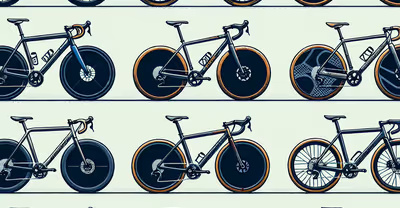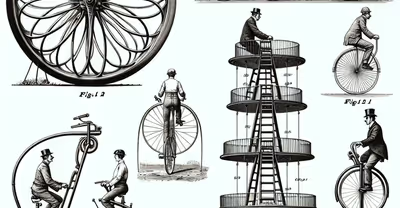
Key Takeaways
- Weight reduction and safety concerns have led to the decline in kickstand popularity.
- Kickstands can pose a hazard, especially for mountain bikers and road cyclists.
- Many high-end bikes omit kickstands for aesthetic and performance reasons.
Ever wondered why bikes don't come with a kickstand? Join us as we unravel this intriguing mystery in the world of cycling.
Bikes omit kickstands mainly for weight savings, versatility, and personal preference. Adding one is simple and affordable, making it a user-driven choice. Ultimately, bikes sans kickstands offer flexibility and customization to riders.
With years of pedal-pounding experience and a passion for all things cycling, I'm your ultimate guide into the world of bikes and kickstands. From fixing flats to fine-tuning gears, I've got the inside scoop to elevate your riding experience.
Why Don't Bikes Come With a Kickstand?
Many people wonder why most modern bikes, especially those designed for mountain biking and road cycling, don't come with a kickstand. The reasons behind this choice by manufacturers are numerous, including concerns about weight, safety, and functionality. In the following paragraphs, we will explore these reasons and more.
One major factor influencing bike design is the quest for lighter and more efficient bicycles. For performance-oriented cyclists, every ounce matters, and the added weight of a kickstand is seen as unnecessary. Moreover, kickstands can pose safety risks as they may catch on obstacles during rides, causing bike failure or crashes.
This is particularly true for mountain bikers navigating rough trails. Additionally, advances in bicycle engineering have shifted the focus away from traditional kickstands, which may not be as stable or secure as other bike support systems. Let’s explore more reasons.
Kickstands Add Weight
The main reason why many bikes don't come with kickstands is that they add extra weight. As a cyclist, weight plays a critical role in the overall performance of your bike. Most high-quality road bikes and mountain bikes are designed to be lightweight, ensuring better performance during rides.
By not including a kickstand, manufacturers can keep the weight down and improve acceleration, speed, and handling. For example, extra weight can significantly affect performance, especially in race conditions.
They’re Not Always Stable
Kickstands don't always provide the best stable support for your bike. On uneven terrain or soft ground, your bike can easily fall over, potentially damaging the frame, components, or painted surface. When your bike is resting on a kickstand, accidental bumps or shifting weight can cause the bike to fall, leading to potential damage or injury.
Kickstands Can Impale You
Another reason why manufacturers avoid including kickstands on bikes is for safety concerns. If you're not careful while mounting or dismounting your bike, a kickstand can impale your leg, leading to serious injury. Eliminating kickstands reduces the risk of injury, making your riding experience safer.
Kickstands Increase The Risk of Bike Damage
Kickstands are potentially dangerous as they can increase the risk of damage to your bike. When your bike is at rest and the wind blows, the kickstand may not be able to maintain stability, leading to the bike falling over and causing scratches or dents to the frame or components.
They Can Snag Things
For mountain bikers and trail riders, kickstands pose an additional risk. They can snag onto vegetation or catch brush while riding down a trail riding, causing an accident or damaging the kickstand. Without a kickstand, mountain bikers can focus solely on navigating the trails without worrying about potential accidents.
They Increase The Risk of Crashing
Kickstands also increase the risk of crashing by adding a sticking point to the bike. If a kickstand unexpectedly opens during a ride, it can cause a loss of control, increasing the chances of an accident. Removing kickstands from bikes allows for a safer riding experience and minimizes the possibility of mishaps caused by kickstand accidents.
Kickstands Are Ugly
Aesthetics play a role in the design of many bikes. Manufacturers try to create sleek, aerodynamic, and visually appealing bicycles to attract customers. Kickstands can hamper the aesthetic and affect the overall look of a bike. By not including a kickstand, bike manufacturers can adhere to a cleaner and more modern design.
Kickstands Add Another Cost
Kickstands add an extra cost to the manufacturing process. By not including kickstands on bicycles, manufacturers can produce bikes at a lower cost. As a result, you might save some money when purchasing a new bike without a kickstand. It is a small consideration but an important one nonetheless, especially when targeting customers looking for budget-friendly options.
How to Support a Bike Without a Kickstand
So you have a bike without a kickstand. Whether it's because most bikes, like expensive bikes and mountain bikes, often don't come with kickstands due to weight reduction goals or other reasons, you still need a way to support your bike when not in use.
In this section, we'll explore a variety of methods to keep your bike upright without the need for a traditional kickstand.
- Lean it against a wall: One of the most common ways to keep a bike upright without a kickstand is to simply lean it against a wall or another sturdy, vertical surface. This method is convenient and easy to execute, requiring no additional hardware or accessories.
- Use a bike stand or bike rack: Many public spaces like parks or shopping areas have bike racks available for use. These are perfect for supporting your bike when you're out and about. Bike parking racks or bike stands designed specifically for home use are also available, offering the convenience of supporting your bike without any modifications to the bike frame.
- Pole or tree support: A common method used by cyclists during rest stops on the trail or while mountain biking is to lean their bikes against a tree or a sturdy pole. This keeps them from lying on the ground, reducing the risk of potential damage.
- Lay your bike down: This might not be the most elegant solution, but it's practical and effective. Just remember, if you have a derailleur on your bike, lay the bike on its non-derailleur side to prevent damage.
- Portable stand: There are lightweight, compact portable bike stands that you can carry with you on rides. These are great for cyclists who frequently need to stop and rest their bikes.
To make this work, lean the left side of your bike (away from the derailleur) against the pole or tree. You can also place the pedal from the non-derailleur side of the bike against the pole to provide extra support.
Here’s a table showing bike supports at a glance:
Steps on How to Install a Kickstand on a Bike
Installing a kickstand on your bike can be a simple and useful addition, especially if your bike doesn't come with a kickstand. In this section, we will guide you through the process of installing an aftermarket kickstand onto your road or mountain bike. Are you ready? Let's dive in.
Preparing for Installation
Before you start, ensure you have the right tools for the job:
- A kickstand designed to fit your bike's frame
- A wrench or Allen key that matches the size of the kickstand bolt
- A soft cloth or pad to protect your bike's paint
Step 1: Choose the Right Location
Select the appropriate spot on your bike's frame to attach the kickstand. Typically, it will be on the left side of the bike, between the chainstays and close to the rear derailleur. Make sure the desired location doesn't interfere with your derailleur, pedal movement, or any other components.
Step 2: Protect Your Bike's Frame
Place a soft cloth or pad underneath the area where you will install the kickstand. This will prevent any damage to your bike's paint during the installation process.
Step 3: Attach the Kickstand
Place the kickstand's main bracket and any additional supporting brackets against your bike's frame, ensuring they fit flush. Insert the bolt through the brackets and into the kickstand, then secure it using a wrench or Allen key. Be careful not to overtighten the bolt, as it may damage your bike's frame.
Step 4: Test the Kickstand
After successfully attaching the kickstand, test it by extending it and resting your bike upright on a flat surface. Ensure your bike is stable and that the kickstand does not interfere with any other elements of the bike. If necessary, adjust the length of the kickstand or its position on the frame.




















































































































































































































































































































































































































































































































































































































































































































































.avif)
